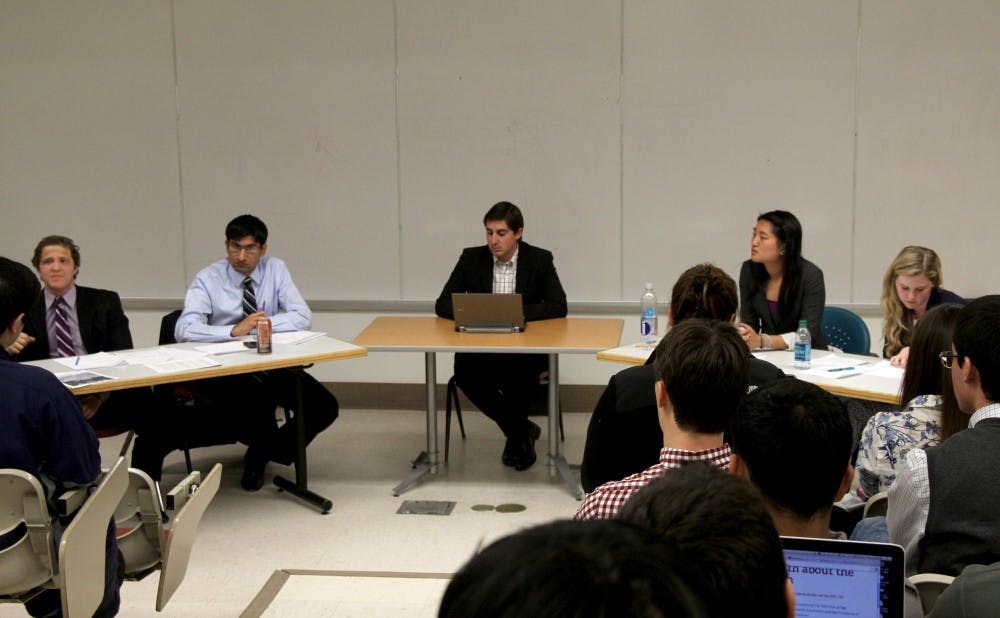Supporters and critics of the 40 Percent Plan came together Thursday night to debate the amendment, which will be on the Duke Student Government election ballot Tuesday, March 4. On the affirmative were the plan's architects seniors Daniel Strunk and Ajeet Hansra. On the negative were DSG President Stefani Jones, a senior, and Student Organization Finance Committee Chair Joyce Lau, a junior. Senior Scott Briggs, editorial pages editor for The Chronicle, moderated. For those who couldn't make it, The Chronicle has hashed out some of the main disputes that came up in the "Great Debate."
1) Campaigning v. Informing
If the 40 Percent Plan passes, students would have to be persuaded that certain student groups are more deserving of their funding allocation than others. Hansra and Strunk called this process “informing” and said student groups may email or talk to students to inform them of the opportunities that come from joining a group or why that group should be funded. Jones and Lau called the process “campaigning” and said groups will have to spend time convincing students that they are worthy of the student allocation instead of spending their fulfilling their missions.

2) Would the plan pit groups against each other?
At the heart of the 40 Percent Plan is the idea that groups would have to compete against each other in order to secure students’ funding allocations. This may lead to winners and losers, but would be more efficient, Hansra and Strunk said. But Jones and Lau said student groups should have equal opportunities for success and for securing funding, which the 40 Percent Plan would not allow.
3) Both sides agree SOFC needs help—is 40 Percent the way to fix it?
Hansra and Strunk argued that the SOFC’s current process is flawed because the students on it do not represent the diversity of the student body. They also listed peer universities’ funding processes, pointing out that they are more comprehensive and representative than SOFC. Jones and Lau refuted these points and added that even if SOFC has problems, the 40 Percent Plan is not the right way to address them—instead SOFC itself could be reformed.

4) Is this a too-costly experiment?
Strunk and Hansra said that at first, the plan will be implemented in a year-long experiment or beta-phase. If in the end, it does not work, the law can be repealed. Jones and Lau argued that it is a costly experiment because it requires significant infrastructure and would subject an entire year of activities’ fees to the 40 Percent Plan. They said if Strunk and Hansra view it as an experiment, student allocation should start on a smaller scale.
5) Most candidates support something—but not necessarily the 40 Percent Plan
Those for and against the 40 Percent Plan said they have the support of the majority of the candidates for the upcoming DSG elections. Strunk and Hansra argued that nearly every candidate has come out in favor of some sort of student allocation plan. But Jones and Lau said that even though this may be true, only one candidate supports the 40 Percent Plan specifically—many support lower levels of student allocation.

Although methods for implementation were a major part of the debate, Jones and Lau pointed out that these details are not part of the 127-word amendment that will be on the ballot. Strunk and Hansra agreed that there are still many details to work out in terms of structure, but they left the amendment open so SOFC leaders can figure out how to best implement it. Additionally, they say they will not disappear after the vote—they will work with incoming leaders to make the plan happen if it passes.
7) Neither side thinks The Chanticleer matters—at least not much
The student yearbook came up frequently as the poster child for inappropriately funded student groups. Strunk said The Chanticleer “does no good for our campus and no one reads it,” so it is not deserving of the around $100,000 it usually gets. But Jones and Lau retaliated, saying SOFC recognized that the yearbook is no longer a major part of the student experience and suggested last year that it should receive $0. (Later, DSG awarded them funding with a $30,000 cut.)Get The Chronicle straight to your inbox
Sign up for our weekly newsletter. Cancel at any time.

